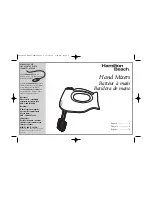
6
CONTROLS AND CONNECTIONS
MONO INPUT CHANNEL
1
➤
GAIN: adjust the gain (sensitivity) of the line and mic inputs,
allowing connections of signal sources (both line and mic level)
having a wide range of signal level. As a practical rule, the GAIN
control must be set to the maximum allowable level that will not
activate the peak level indicator. This will maximize the signal to
noise ratio.
2
➤
H.F / MID FREQ. / MID LEVEL / L.F: 3-band equalizer with
parametric control of the mid range. While the High and Low
controls act on fixed frequency cuts, the Mid control allows to
choose the frequency to be lowered or raised.
H.F: adjusts the amount of boost or cut in the high frequency
range. Turning the control clockwise increases the amount of high
frequencies, counter-clockwise decreases it.
MID FREQ.: chooses the frequency to be lowered or raised.
MID LEVEL: adjusts the amount of boost or cut in the frequency
choosen by means of the MID FREQ. control.
Note
: If the MID LEVEL control is set at '0' (centre) there will be no alteration in
the mid frequency band (independently of the MID FREQ. control setting).
L.F: adjusts the amount of boost or cut in the low frequency range.
Turning the control clockwise increases the amount of low frequen-
cies, counter-clockwise decreases it.
3
➤
A / B: monitor sends volumes (pre fader, post tone controls).
They set the level of that input channel in the monitor outputs.
4
➤
1 / 2: effect sends volumes (post fader and post tone controls).
They adjust the quantity of channel signal that is sent both to the
correspondent built-in effect and to an external effect connected
to the 'EFF SEND 1/2' and to the 'STEREO EFF. RET. 1/2' sockets.
Note:
On the channels where you don't want to have neither the internal effect
nor the external effect, turn these knobs fully anticlockwise.
Should the external effect only be required, then turn off the internal effect.
5
➤
PAN: this control allows to place the channel’s input signal
within the stereo image by assigning more or less of the signal
to the left or right master volume controls.
6
➤
PEAK: peak LED indicator. It lights when the signal level is
approaching the maximum (clipping) allowable level. The signal
is sampled in two points of the channel's signal path: • after the
input amplifier (micro and line); • after the equalizer.
If the LED is continuously lighted, you must reduce the input GAIN
or modify the equalizer settings, reducing the boost introduced by
the level controls HF, MID LEVEL and LF.
7
➤
Channel VOLUME fader.
8
➤
PHANTOM 48V DC: pushbutton for on/off switching of the
48V phantom power supply on the channels 5, 6, 7, 8 (the phantom
power supply allows use of condenser microphones).
Note
: Before pushing this button, make sure that the unit is turned off or that
all the slider controls are to their lowest settings.
●
connections:
9
➤
MIC: balanced XLR microphone input (for microphones).
10
➤
LINE: unbalanced jack line input (for instruments and high
level sources).
Note
: Do not use both the MIC and the LINE input of one channel at the
same time).
Do not connect instruments or other high level sources to the MICRO inputs
(this will result in distortion due to excessive signal level).
Do not connect microphones to the LINE inputs (the resulting signal will be
of low level and low quality) .
STEREO INPUT CHANNEL
11
➤
GAIN:
same as in the mono channel
.
12
➤
H.F / M.F / L.F.: 3-band equalizer.
H.F: adjusts the amount of high frequencies giving up to 15dB of
boost or cut at 15kHz.
M.F: adjusts the amount of mid frequencies giving up to 15dB of
boost or cut at 600Hz.
L.F: adjusts the amount of low frequencies giving up to 15dB of
boost or cut at 50Hz.
Note
: Turning the control clockwise increases the amount of high, mid or low
frequencies, counter-clockwise decreases it. The reaponse is flat at the center
position.
13
➤
A / B:
same as in the mono channel.
14
➤
1 / 2:
same as in the mono channel.
15
➤
BAL: stereo balance. Allows to adjust the level of the input
signal in the left or right master outputs. If the channel is used as
a mono channel it becomes a PAN control.
16
➤
PEAK:
same as in the mono channel.
17
➤
Channel VOLUME fader.
●
connections:
18
➤
L/R: unbalanced jack line inputs for stereo instruments.
For 'mono' connections use 'L / mono' input.
Содержание 716 S
Страница 1: ...stereo powered mixer stereo powered mixer 71 716S S...
Страница 17: ...APPENDIX 17 71 716S S stereo powered mixer stereo powered mixer...
Страница 19: ...BLOCK DIAGRAM 19...







































